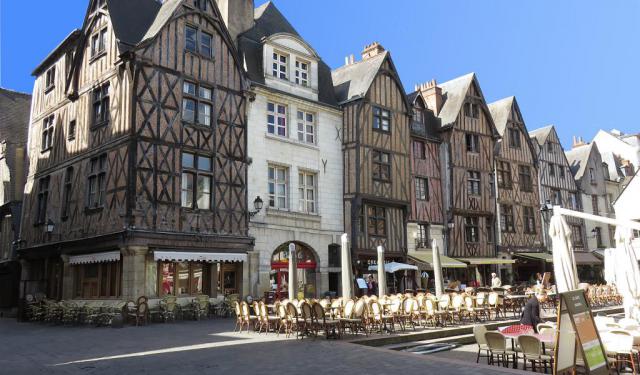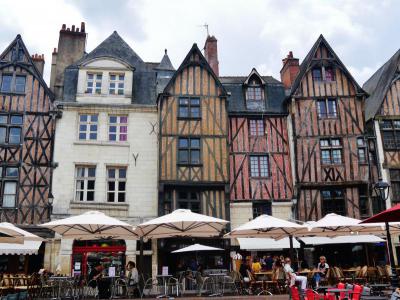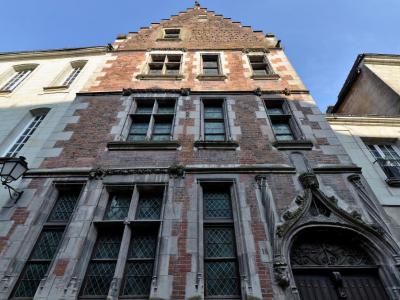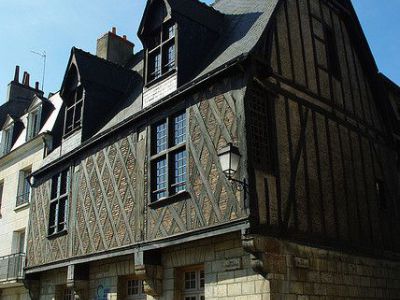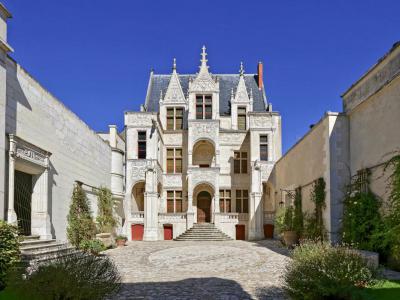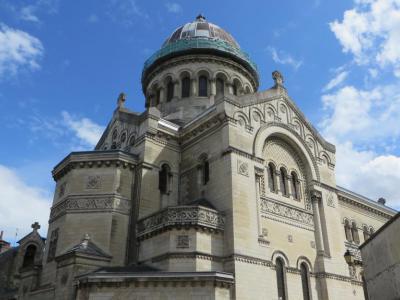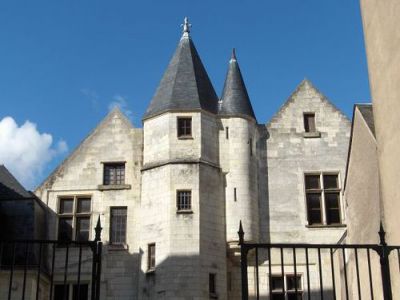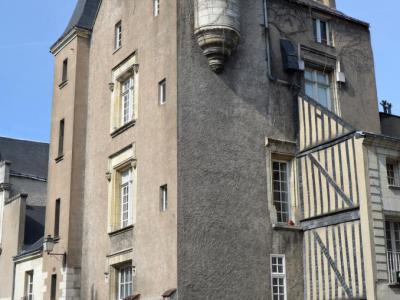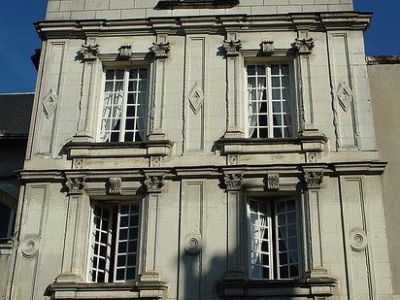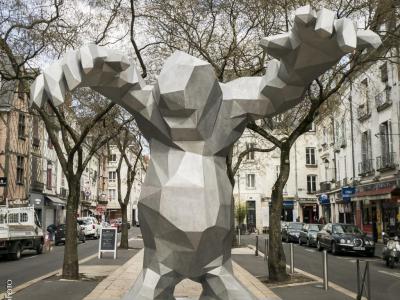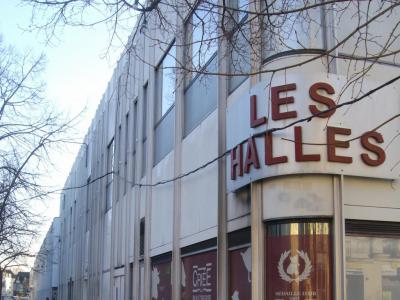Tours Old Town Walk (Self Guided), Tours
Having successfully preserved much of its historic heritage, Tours is particularly famous for its original medieval district – Vieux Tours. The bulk of it is concentrated around three squares: Place du Grand Marché, Place Plumereau and Place de Chateauneuf.
A stroll through the Old Town, day or night, offers many delights, and is best started at Place Plumereau. Lined with wood-framed, stone-gabled townhouses dating back to the 12th-15th centuries and carefully restored in the spirit of the time, this square is known for its exuberant atmosphere from the multitude of cafes, bars and restaurants of every kind, owing to which the place enjoys the title of the “best in France for aperitif.”
All round Place Plumereau are a hodgepodge of cobbled streets with more eateries and shops to explore. Alongside lovely half-timber buildings there you will find Saint Martin's Basilica – a late 19th-century neo-Byzantine building erected to honour the relics of St Martin, rediscovered in 1860 and now housed in the crypt; the Charlemagne Tower – one of the towers of the Saint-Martin basilica; and more.
A good number of historic sights are located in the ancient neighborhood of Chateauneuf. Place de Chateauneuf (New Castle Square) – originally built in the 15th century, has been subjected recently to a major renovation.
To the west of the former Saint-Martin abbey lies Place du Grand Marché (Main Market Square) or Monster Square, as they call it, because of the statue. To the north of Place Plumereau there are ruins of the Saint Peter the Puellier Church, founded in 512.
There is nothing like a walk in the pedestrian-friendly Vieux Tours, abounding in sights fit to please any ardent history lover. If you wish to unwind the meanders of the picturesque streets therein, whilst admiring the old-time monuments, take this self-guided walking tour.
A stroll through the Old Town, day or night, offers many delights, and is best started at Place Plumereau. Lined with wood-framed, stone-gabled townhouses dating back to the 12th-15th centuries and carefully restored in the spirit of the time, this square is known for its exuberant atmosphere from the multitude of cafes, bars and restaurants of every kind, owing to which the place enjoys the title of the “best in France for aperitif.”
All round Place Plumereau are a hodgepodge of cobbled streets with more eateries and shops to explore. Alongside lovely half-timber buildings there you will find Saint Martin's Basilica – a late 19th-century neo-Byzantine building erected to honour the relics of St Martin, rediscovered in 1860 and now housed in the crypt; the Charlemagne Tower – one of the towers of the Saint-Martin basilica; and more.
A good number of historic sights are located in the ancient neighborhood of Chateauneuf. Place de Chateauneuf (New Castle Square) – originally built in the 15th century, has been subjected recently to a major renovation.
To the west of the former Saint-Martin abbey lies Place du Grand Marché (Main Market Square) or Monster Square, as they call it, because of the statue. To the north of Place Plumereau there are ruins of the Saint Peter the Puellier Church, founded in 512.
There is nothing like a walk in the pedestrian-friendly Vieux Tours, abounding in sights fit to please any ardent history lover. If you wish to unwind the meanders of the picturesque streets therein, whilst admiring the old-time monuments, take this self-guided walking tour.
How it works: Download the app "GPSmyCity: Walks in 1K+ Cities" from Apple App Store or Google Play Store to your mobile phone or tablet. The app turns your mobile device into a personal tour guide and its built-in GPS navigation functions guide you from one tour stop to next. The app works offline, so no data plan is needed when traveling abroad.
Tours Old Town Walk Map
Guide Name: Tours Old Town Walk
Guide Location: France » Tours (See other walking tours in Tours)
Guide Type: Self-guided Walking Tour (Sightseeing)
# of Attractions: 11
Tour Duration: 1 Hour(s)
Travel Distance: 1.6 Km or 1 Miles
Author: Linda
Sight(s) Featured in This Guide:
Guide Location: France » Tours (See other walking tours in Tours)
Guide Type: Self-guided Walking Tour (Sightseeing)
# of Attractions: 11
Tour Duration: 1 Hour(s)
Travel Distance: 1.6 Km or 1 Miles
Author: Linda
Sight(s) Featured in This Guide:
- Place Plumereau (Plum Square)
- Eglise Saint Pierre le Puellier (Saint Peter the Puellier Church)
- Maison de Tristan (Tristan House)
- Maison du Croissant (House of the Crescent)
- Hôtel Gouin (Gouin House)
- Basilica of St. Martin
- Place de Chateauneuf (New Castle Square)
- Jean Briconnet Hotel (Jean Briconnet Mansion)
- Eglise Sainte Croix (Holy Cross Church)
- Place du Grand Marché (Main Market/Monster Square)
- Les Halles (Market Halls)
1) Place Plumereau (Plum Square) (must see)
The most touristy place in Tours is the Place Plumereau, or as the locals call it "PlumSquare." Not only popular for visitors, it is also a favorite watering hole for students and the locals. It is in the center of the Saint-Martin district of the city, a very historic area of Tours old town.
The place was not always named Place Plumereau. It was known as Carroi aux Chapeaux in the 13th century, Fruits Square in 1816, and Carroi des Quenouilles. Finally, on 18 November 1888, it became Place Plumereau.
The square is named Plumereau in honor of M. Charles Plumereau (1818-1885). M. Plumereau had no family or heirs. He was a city councilor and when he died he bequeathed 3,000 francs to the city.
The square is lined with half-timbered houses and mansions with Renaissance and Romanesque facades from the 15th century. The square is close to the local university. This makes it a popular spot for students. With the students, locals, and tourists, things can be quite crowded at times.
Seating is no problem. Most of the restaurants and cafes set out chairs on the streets and terraces even in winter.
The place was not always named Place Plumereau. It was known as Carroi aux Chapeaux in the 13th century, Fruits Square in 1816, and Carroi des Quenouilles. Finally, on 18 November 1888, it became Place Plumereau.
The square is named Plumereau in honor of M. Charles Plumereau (1818-1885). M. Plumereau had no family or heirs. He was a city councilor and when he died he bequeathed 3,000 francs to the city.
The square is lined with half-timbered houses and mansions with Renaissance and Romanesque facades from the 15th century. The square is close to the local university. This makes it a popular spot for students. With the students, locals, and tourists, things can be quite crowded at times.
Seating is no problem. Most of the restaurants and cafes set out chairs on the streets and terraces even in winter.
2) Eglise Saint Pierre le Puellier (Saint Peter the Puellier Church)
The Church of Saint Peter the Puellier, located just north of the Place Plumereau in Tours, is a site steeped in history and architectural heritage, albeit mostly in ruins today. Originally established in 512 by Clotilde, the wife of King Franc Clovis, this site once served as a collegiate church for an ancient monastery.
Throughout its history, the church underwent significant transformations. The most substantial building effort took place around 1170, culminating roughly a decade later. This construction embraced the Western Gothic architectural style, characterized by a nave flanked by side aisles, a transept, and an east-facing choir with a flat apse. It likely featured a bell tower with a spire at the transept's crossing.
During the French Revolution, the church was sold as national property and nearly destroyed. Today, only parts of it remain, including sections of a side aisle now converted into a residential dwelling. Specifically, the first and second spans of the north aisle survive, transformed into living spaces with a new floor dividing the space into two levels. One room still features its original Western Gothic vault.
Additionally, the northern wall of the second bay features two semicircular bays adorned with decorative cords, showcasing the original architectural details, whereas the bays lighting the east and south are modern additions. The visible capitals near the northeast of the building are preserved in their original state, contrasting with those to the southeast, which have been restored.
These architectural remains have been recognized as historical monuments since 1946, underscoring their cultural and historical importance despite the extensive destruction they have endured. The Church of Saint Peter the Puellier, in its current form, serves as a poignant reminder of the rich history that has shaped Tours, standing as a testament to both its medieval past and the tumultuous periods that followed.
Throughout its history, the church underwent significant transformations. The most substantial building effort took place around 1170, culminating roughly a decade later. This construction embraced the Western Gothic architectural style, characterized by a nave flanked by side aisles, a transept, and an east-facing choir with a flat apse. It likely featured a bell tower with a spire at the transept's crossing.
During the French Revolution, the church was sold as national property and nearly destroyed. Today, only parts of it remain, including sections of a side aisle now converted into a residential dwelling. Specifically, the first and second spans of the north aisle survive, transformed into living spaces with a new floor dividing the space into two levels. One room still features its original Western Gothic vault.
Additionally, the northern wall of the second bay features two semicircular bays adorned with decorative cords, showcasing the original architectural details, whereas the bays lighting the east and south are modern additions. The visible capitals near the northeast of the building are preserved in their original state, contrasting with those to the southeast, which have been restored.
These architectural remains have been recognized as historical monuments since 1946, underscoring their cultural and historical importance despite the extensive destruction they have endured. The Church of Saint Peter the Puellier, in its current form, serves as a poignant reminder of the rich history that has shaped Tours, standing as a testament to both its medieval past and the tumultuous periods that followed.
3) Maison de Tristan (Tristan House)
The house of Tristan L'Hermite is a private mansion located in the old town of Tours. The building has been classified as a historical monument since 1862.
The house belonged to Tristan L'Hermite, a French officer who successively served the kings of France Charles VI, Charles VII and Louis XI. L'Hermite is known as a master of the artillery. He was also in charge of the high police force and the discipline of the Royal armies. His bravery during the siege of Fronsac earned him a knight in June 1451.
The building's brick and stone facade has a singular Flemish influence with its large stepped gable. Inside, it has a beautiful brick Saint-Gilles spiral staircase in a tower, with a belvedere at the top.
In the 17th century, the mansion was acquired by Jean Charles Viot, a dealer in silks and judge-consul, who also built the neighboring hotel. Today it is the headquarters of the European Institute for the History and Cultures of Food (IEHCA).
The house belonged to Tristan L'Hermite, a French officer who successively served the kings of France Charles VI, Charles VII and Louis XI. L'Hermite is known as a master of the artillery. He was also in charge of the high police force and the discipline of the Royal armies. His bravery during the siege of Fronsac earned him a knight in June 1451.
The building's brick and stone facade has a singular Flemish influence with its large stepped gable. Inside, it has a beautiful brick Saint-Gilles spiral staircase in a tower, with a belvedere at the top.
In the 17th century, the mansion was acquired by Jean Charles Viot, a dealer in silks and judge-consul, who also built the neighboring hotel. Today it is the headquarters of the European Institute for the History and Cultures of Food (IEHCA).
4) Maison du Croissant (House of the Crescent)
The House of the Crescent (Maison du Croissant), also known as the Maison de la Belle Teinturière, is a fine example of a Medieval French mansion. Built sometime between the second half of the 15th century and the first quarter of the 16th century, this palatial bourgeois house stands in the area that was once inhabited by silk workers, who settled in Tours around 1470 at the behest of King Louis XI.
The building owes its name to the Tufa staircase tower, standing on one of its corners. The coat of arms of Saint Maurice, which crowns the front door of the tower, with a motto in the form of a crescent, refers to the Order of the Crescent established in 1448 by René d'Anjou. However, no archival documents make it possible to establish precisely the relationship between this house and the knightly order.
The Gothic-style front door seems to have been installed during restoration in 1962, led by the architect Henri Enguehard. That restoration notably replaced the initial cob slabs on the façade with the decorative brick slabs. Several windows also have been restored to their original location and size, including those on the ground floor of the tower and the two square floors of the timber-framed upper part of the main building.
The ground floor of the house is corbelled. The north façade, damaged during WWII, has been restored and is partly modern. The building has been registered as a historical monument since 1946.
The building owes its name to the Tufa staircase tower, standing on one of its corners. The coat of arms of Saint Maurice, which crowns the front door of the tower, with a motto in the form of a crescent, refers to the Order of the Crescent established in 1448 by René d'Anjou. However, no archival documents make it possible to establish precisely the relationship between this house and the knightly order.
The Gothic-style front door seems to have been installed during restoration in 1962, led by the architect Henri Enguehard. That restoration notably replaced the initial cob slabs on the façade with the decorative brick slabs. Several windows also have been restored to their original location and size, including those on the ground floor of the tower and the two square floors of the timber-framed upper part of the main building.
The ground floor of the house is corbelled. The north façade, damaged during WWII, has been restored and is partly modern. The building has been registered as a historical monument since 1946.
5) Hôtel Gouin (Gouin House)
The Gouin House (Hôtel Goüin), located in Tours, is a historic mansion with a rich architectural and cultural history. Built in the 15th century, the mansion was mistakenly believed to have been the residence of Jean de Xaincoings, a treasurer for Charles VII. However, historical records clarify that its original owner was René Gardette, a descendant of a prominent silk merchant family from Tours.
In the 16th century, the facade of the building underwent significant modifications, including the addition of a porch and loggia in the early Renaissance style, as well as a new left wing. Notably, the sub-basement of the Hôtel Goüin preserves remnants from the Gallo-Roman period, linking it to the ancient past of the region.
The building's modern name derives from the Goüin family, affluent Breton bankers who acquired it in 1738. They made substantial improvements, such as adding a balcony over the rear courtyard, demolishing adjacent houses to enlarge the southern yard, and constructing a new entry gate. These modifications significantly altered the building's structure and appearance.
World War II brought devastation to the Hôtel Goüin when it was nearly destroyed by bombings in 1944, leaving only the facade standing. The 1950s saw partial restoration efforts, primarily focusing on the main accommodation and the entrance, though the original garden and north yard were lost and never restored.
Today, the building is home to the Goüin Museum and previously housed the Touraine Archeological Society. Its cultural significance was highlighted in 1967 when it was featured on a 0.40 franc postage stamp issued for the 40th Congress of the French Federation of Philatelic Societies - this marked recognition of the building’s architectural and historical value within the broader context of French heritage.
In the 16th century, the facade of the building underwent significant modifications, including the addition of a porch and loggia in the early Renaissance style, as well as a new left wing. Notably, the sub-basement of the Hôtel Goüin preserves remnants from the Gallo-Roman period, linking it to the ancient past of the region.
The building's modern name derives from the Goüin family, affluent Breton bankers who acquired it in 1738. They made substantial improvements, such as adding a balcony over the rear courtyard, demolishing adjacent houses to enlarge the southern yard, and constructing a new entry gate. These modifications significantly altered the building's structure and appearance.
World War II brought devastation to the Hôtel Goüin when it was nearly destroyed by bombings in 1944, leaving only the facade standing. The 1950s saw partial restoration efforts, primarily focusing on the main accommodation and the entrance, though the original garden and north yard were lost and never restored.
Today, the building is home to the Goüin Museum and previously housed the Touraine Archeological Society. Its cultural significance was highlighted in 1967 when it was featured on a 0.40 franc postage stamp issued for the 40th Congress of the French Federation of Philatelic Societies - this marked recognition of the building’s architectural and historical value within the broader context of French heritage.
6) Basilica of St. Martin (must see)
The beginning of the story of the Basilica of Saint Martin goes all the way back to the 4th Century, when a small chapel was established here. The chapel was dedicated to Saint Martin, who was the bishop of Tours at that time. Destroyed and rebuilt many times since, it was architect Victor Laloux that designed the Roman-Byzantine basilica on the site today.
The first basilica was built in the fifth century over the ruins of an earlier chapel. The basilica was dedicated to Saint Martin of Tours and it was erected over his tomb. Alcuin, an adviser of Charlemagne, was appointed Abbot of the monastic establishment of Saint-Martin's, developed as a collegiate church and governed by a community of canons.
The medieval chapel was destroyed in the French Revolution. Only two old towers connected to the medieval chapel are still standing today. Between the years of 1896 and 1924 the present church was built by Victor Laloux in a neo-Byzantine style on the site of the original basilica. The church was dedicated in 1925.
It has been said the exterior design is reminiscent of an old European synagogue. The interior has white stone walls and stained glass windows showing scenes in the life of the Saint. The new, modern crypt of the church holds the remains of Saint Martin.
The Basilica is located in the Tours Old Town. Saint Martin was third bishop of Tours. He is one of the most familiar and recognizable Christian saints in France. Because of his military experience and his leadership of French Christians, Saint Martin is seen as a protector of France.
The first basilica was built in the fifth century over the ruins of an earlier chapel. The basilica was dedicated to Saint Martin of Tours and it was erected over his tomb. Alcuin, an adviser of Charlemagne, was appointed Abbot of the monastic establishment of Saint-Martin's, developed as a collegiate church and governed by a community of canons.
The medieval chapel was destroyed in the French Revolution. Only two old towers connected to the medieval chapel are still standing today. Between the years of 1896 and 1924 the present church was built by Victor Laloux in a neo-Byzantine style on the site of the original basilica. The church was dedicated in 1925.
It has been said the exterior design is reminiscent of an old European synagogue. The interior has white stone walls and stained glass windows showing scenes in the life of the Saint. The new, modern crypt of the church holds the remains of Saint Martin.
The Basilica is located in the Tours Old Town. Saint Martin was third bishop of Tours. He is one of the most familiar and recognizable Christian saints in France. Because of his military experience and his leadership of French Christians, Saint Martin is seen as a protector of France.
7) Place de Chateauneuf (New Castle Square)
New Castle Square (Place de Chateauneuf) is one of the most beautiful places in Tours. The square lies at the foot of the Charlemagne Tower, which is one of the four towers of the ancient Basilica of Saint Martin. Beside the Tower, one can see the remains of the old basilica itself, built between the 11th and the 13th centuries over the tomb of the bishop of Tours.
Another key attraction on the square is the Mansion of the Dukes of Touraine, dating back to the 14th century. The palatial residence consists of two buildings with gables overlooking a courtyard and a Gothic-style octagonal tower in between.
The name Chateauneuf (“New Castle”) refers to the historic town that evolved around the Abbey of St Martin back in the 9th century. Attesting to this are the ancient fortifications dating from that period.
By the 2010s, the square had found itself cluttered with vehicles and in much need of renovation. In 2017, Place de Châteauneuf finally received a facelift and was made entirely pedestrian. The gentrified area now boasts ample green spaces, and benches, and is soon to be replenished with the Beaune-Semblançay fountain moved from Rue Nationale.
Another key attraction on the square is the Mansion of the Dukes of Touraine, dating back to the 14th century. The palatial residence consists of two buildings with gables overlooking a courtyard and a Gothic-style octagonal tower in between.
The name Chateauneuf (“New Castle”) refers to the historic town that evolved around the Abbey of St Martin back in the 9th century. Attesting to this are the ancient fortifications dating from that period.
By the 2010s, the square had found itself cluttered with vehicles and in much need of renovation. In 2017, Place de Châteauneuf finally received a facelift and was made entirely pedestrian. The gentrified area now boasts ample green spaces, and benches, and is soon to be replenished with the Beaune-Semblançay fountain moved from Rue Nationale.
8) Jean Briconnet Hotel (Jean Briconnet Mansion)
Jean Briconnet Mansion (Jean Briconnet Hotel), located in the charming city of Tours, is a historic residence steeped in the rich tapestry of French history. Originally constructed in the 15th century, this private mansion was built for the influential Berthelot family, a prominent local lineage. As the story unfolds, the residence came into the possession of Jean Briçonnet, the first Mayor of Tours, through his marriage to Jeanne Berthelot.
Jean Briçonnet, a notable figure in Tours' history, left a lasting mark on the property. After acquiring it, he undertook significant renovations and embedded his coat of arms in the northern logis of the building, thereby leaving a personal and historical imprint. Briçonnet passed away in 1493, but his legacy and modifications to the building have endured through the ages.
Over the centuries, the Jean Briconnet Mansion has witnessed numerous transformations. In the late 19th century, the construction and alignment of Rue de Chateauneuf nearly bisected the building, leading to the demolition of part of it. Despite these changes, the essence and historical significance of the mansion have been preserved. Its recognition as a French historical monument since January 1928 underscores its importance and protects its architectural and historical integrity.
Today, the Jean Briconnet Mansion sits at the intersection of Rue de Chateauneuf and Rue du Change, inviting visitors to explore and appreciate its historical grandeur. It offers a unique window into the past, allowing individuals to immerse themselves in the architectural and societal developments of Tours over the centuries.
Jean Briçonnet, a notable figure in Tours' history, left a lasting mark on the property. After acquiring it, he undertook significant renovations and embedded his coat of arms in the northern logis of the building, thereby leaving a personal and historical imprint. Briçonnet passed away in 1493, but his legacy and modifications to the building have endured through the ages.
Over the centuries, the Jean Briconnet Mansion has witnessed numerous transformations. In the late 19th century, the construction and alignment of Rue de Chateauneuf nearly bisected the building, leading to the demolition of part of it. Despite these changes, the essence and historical significance of the mansion have been preserved. Its recognition as a French historical monument since January 1928 underscores its importance and protects its architectural and historical integrity.
Today, the Jean Briconnet Mansion sits at the intersection of Rue de Chateauneuf and Rue du Change, inviting visitors to explore and appreciate its historical grandeur. It offers a unique window into the past, allowing individuals to immerse themselves in the architectural and societal developments of Tours over the centuries.
9) Eglise Sainte Croix (Holy Cross Church)
The Sainte-Croix Church in Tours is a historic monument, listed on December 19, 1939. Set in the Old Town, between rue de Châteauneuf to the South and rue Henri-Royer to the West, this 13th-century edifice was built on the site of an even older monastery, founded in the 6th century by Sainte Radegonde, wife of Merovingian King Clotaire I.
The design follows the pattern generally adopted by Christian churches of the period – choir to the east and nave to the west. It has a single-span nave, a transept, and a choir. The cross of the transept and the choir are narrower than the nave. The nave's vault, of Western Gothic style, rests on Romanesque piles. The western facade changed significantly in the 15th century following the construction of an adjacent building.
The northern part of the transept, vaulted with a semicircular cradle, is connected to the cross of the transept by a large semicircular opening. It is extended to the east by a chapel, covered with a so-called Angevin vault, featuring the same style as that of the nave. The choir, terminated by a flat apse, is only lit by two windows on the northern side.
Except for its south facade, floors, and internal partitions, the building represents a historic heritage. The rectory, adjacent to the north gutter wall of its nave, is also listed as a historic monument.
The design follows the pattern generally adopted by Christian churches of the period – choir to the east and nave to the west. It has a single-span nave, a transept, and a choir. The cross of the transept and the choir are narrower than the nave. The nave's vault, of Western Gothic style, rests on Romanesque piles. The western facade changed significantly in the 15th century following the construction of an adjacent building.
The northern part of the transept, vaulted with a semicircular cradle, is connected to the cross of the transept by a large semicircular opening. It is extended to the east by a chapel, covered with a so-called Angevin vault, featuring the same style as that of the nave. The choir, terminated by a flat apse, is only lit by two windows on the northern side.
Except for its south facade, floors, and internal partitions, the building represents a historic heritage. The rectory, adjacent to the north gutter wall of its nave, is also listed as a historic monument.
10) Place du Grand Marché (Main Market/Monster Square)
Looking like a not-so-handsome cousin of The Hulk, only paler, the "Monster " dominates the Place du Grand Marche also known as "Monster Square."
The square had been known as the Main Market since the 15th century. In those days there may have been statues of monsters but they looked not so comically forbidding. The Market Square was simply an area between High Street and Saint Clement.
In the 16th century, Pierre Germain Valencia and his son erected the largest fountain in the city there. The fountain was 26 feet high and 20 feet across. Now the "Monster" stands in its place.
In 1845 the Square was enlarged by eliminating some butcher shops in the northern part of the square. By municipal decree of January 1905, the name of the square officially became Place du Grande Marche. The square is surrounded by 15th-century houses and shops jammed together in a row.
Today the tradition of the market carries on with the unique Saint Anne Garlic and Basil Fair in July. It's a great time to stock up on garlic, shallots, onions, and basil. A true festival of the Touraine region. This is no longer the primary purpose of the Square. The Market Halls are but a short walk away.
The flea markets may not be the answer, but the square is still very rambunctious. Bars, restaurants, and shops are plenty and then there is the Monster. Somehow this incongruous thing forms a missing link between the Middle Ages and the age of Mickey Mouse.
The square had been known as the Main Market since the 15th century. In those days there may have been statues of monsters but they looked not so comically forbidding. The Market Square was simply an area between High Street and Saint Clement.
In the 16th century, Pierre Germain Valencia and his son erected the largest fountain in the city there. The fountain was 26 feet high and 20 feet across. Now the "Monster" stands in its place.
In 1845 the Square was enlarged by eliminating some butcher shops in the northern part of the square. By municipal decree of January 1905, the name of the square officially became Place du Grande Marche. The square is surrounded by 15th-century houses and shops jammed together in a row.
Today the tradition of the market carries on with the unique Saint Anne Garlic and Basil Fair in July. It's a great time to stock up on garlic, shallots, onions, and basil. A true festival of the Touraine region. This is no longer the primary purpose of the Square. The Market Halls are but a short walk away.
The flea markets may not be the answer, but the square is still very rambunctious. Bars, restaurants, and shops are plenty and then there is the Monster. Somehow this incongruous thing forms a missing link between the Middle Ages and the age of Mickey Mouse.
11) Les Halles (Market Halls)
Market Halls (Les Halles) represents a significant historical and gastronomic hub in the heart of Tours. Located on the Place Gaston-Paillhou, the modern structure that stands today is often likened to a white steamship liner due to its distinctive design, featuring steel, plexiglass, and glass. This bustling market space offers a plethora of shopping options including bakeries, butchers, delis, dairies, fruit and vegetable stalls, a wine cellar, and caterers on the ground floor. The top floor houses offices and studios, adding a commercial element to the building.
Market Halls originated in 1866, designed by Gustave Guérin and inspired by Victor Baltard's Paris Halles. Initially located at Place d'Aumont, now Gaston-Paillhou Square, the market expanded after demolishing two churches, Saint-Martin and Saint-Clement. It remained a key food market until its demolition in 1976, three years after losing its wholesale function, a change regretted by the community.
In 1980, the city unveiled a new, modernized building to continue the tradition of the market, enhancing comfort, hygiene, and accessibility with underground parking. Despite some nostalgic sentiments for the old structure, the new building has been embraced for its futuristic aesthetics and its continued role in revitalizing the historic district. It is admired for its innovative design, reminiscent of Paris's Forum des Halles, earning it the nickname "the liner."
Today, Market Halls stands as a vibrant gastronomic center, maintaining its historical essence as a place where locals and visitors alike can find a comprehensive range of fresh products, from breads and pastries to delicatessens and wines, all under one roof. This market not only preserves a 150-year tradition of culinary excellence in Touraine but also serves as a central point for community life and commerce in Tours.
Market Halls originated in 1866, designed by Gustave Guérin and inspired by Victor Baltard's Paris Halles. Initially located at Place d'Aumont, now Gaston-Paillhou Square, the market expanded after demolishing two churches, Saint-Martin and Saint-Clement. It remained a key food market until its demolition in 1976, three years after losing its wholesale function, a change regretted by the community.
In 1980, the city unveiled a new, modernized building to continue the tradition of the market, enhancing comfort, hygiene, and accessibility with underground parking. Despite some nostalgic sentiments for the old structure, the new building has been embraced for its futuristic aesthetics and its continued role in revitalizing the historic district. It is admired for its innovative design, reminiscent of Paris's Forum des Halles, earning it the nickname "the liner."
Today, Market Halls stands as a vibrant gastronomic center, maintaining its historical essence as a place where locals and visitors alike can find a comprehensive range of fresh products, from breads and pastries to delicatessens and wines, all under one roof. This market not only preserves a 150-year tradition of culinary excellence in Touraine but also serves as a central point for community life and commerce in Tours.
Walking Tours in Tours, France
Create Your Own Walk in Tours
Creating your own self-guided walk in Tours is easy and fun. Choose the city attractions that you want to see and a walk route map will be created just for you. You can even set your hotel as the start point of the walk.
Tours Introduction Walking Tour
The Roman Emperor Augustus named the city Caesarodunum (Hill of Caesar). But it was always Tours. Caesar left the Tours Ampitheatre, the largest amphitheater of the Empire. It's good to be Caesar.
Tours is located on the River Loire. It stands between Orleans and the Atlantic shore. It is famous for the Battle of Tours in 732 CE when Spanish Moors led by Abdul Rahman Al Ghafiqi was... view more
Tour Duration: 2 Hour(s)
Travel Distance: 3.7 Km or 2.3 Miles
Tours is located on the River Loire. It stands between Orleans and the Atlantic shore. It is famous for the Battle of Tours in 732 CE when Spanish Moors led by Abdul Rahman Al Ghafiqi was... view more
Tour Duration: 2 Hour(s)
Travel Distance: 3.7 Km or 2.3 Miles
Historical Churches
The French city of Tours is forever linked to the Battle of Tours, a pivotal event in European history. Taking place in 732 AD, this momentous encounter saw the Frankish leader Charles Martel, a devout Christian, successfully repel a substantial army of Spanish Moors, thus effectively halting the Muslim advance and ensuring the preservation of Christianity throughout Western Europe.
Had it... view more
Tour Duration: 1 Hour(s)
Travel Distance: 2.7 Km or 1.7 Miles
Had it... view more
Tour Duration: 1 Hour(s)
Travel Distance: 2.7 Km or 1.7 Miles
The Most Popular Cities
/ view all
